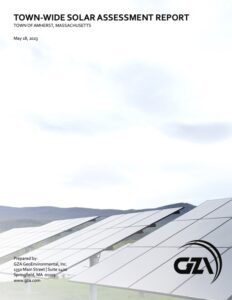Who is a member?
Our members are the local governments of Massachusetts and their elected and appointed leadership.
 The town of Amherst recently completed a townwide solar assessment as a part of an effort to reach carbon neutrality by 2050. As a result, the town now has a mapping tool that shows where solar is feasible for the town, as well as for businesses and residents who may be interested in solar installation in the future.
The town of Amherst recently completed a townwide solar assessment as a part of an effort to reach carbon neutrality by 2050. As a result, the town now has a mapping tool that shows where solar is feasible for the town, as well as for businesses and residents who may be interested in solar installation in the future.
The town’s Energy and Climate Action Committee had identified renewable energy development as a major pathway toward meeting the carbon neutrality goals set in its Climate Action, Adaptation and Resilience Plan. The town has also formed a Solar Bylaw Working Group.
“The town is wanting to move toward electrification of municipal buildings and will need to move toward renewable energy sources to reduce carbon,” said Sustainability Director Stephanie Ciccarello.
“We want more options for local solar and microgrid development,” she said. “So where in town is a good fit for those options? What are our potential development opportunities for solar?”
The assessment, done in partnership with GZA GeoEnvironmental, included extensive public engagement, with a survey and virtual and in-person feedback sessions, as well as a feature on the town’s online public engagement platform, EngageAmherst.com.
The new solar map shows where projects could be sited, including on residential and private properties, so that the town can support property owners in installing solar. The map excludes any areas that would not be feasible for solar installation, including land owned by area colleges and universities, land with conservation restrictions, and land under wetlands protections, as well as any parcels with logistical challenges. Areas that were not excluded are assigned a feasibility score.
“The really important thing is that our mapping tool is not definitive in that this is where solar can go,” Ciccarello said. “It’s about feasibility. These are areas that would be best, so maybe solar can go there, and these are the areas that would not work.”
The final report contains an extensive look at feedback gathered from department heads and the community as a part of the Community Preference Assessment, with the goal of understanding opinions and sentiments regarding solar development.
“One of the important things that came from this process is the conversations that people have had within the community regarding solar development impacts on land use,” Ciccarello said. “They are difficult conversations to have, but you have to have them because the community needs to decide what they would support moving forward.”